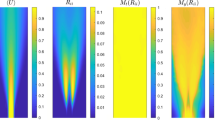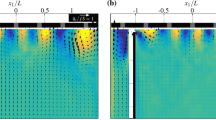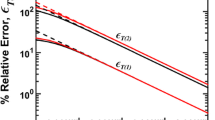Abstract
The quantification of turbulent mixing in nature is predicated by inherent randomness of causal events, and obtaining relevant turbulence statistics requires ensemble averaging of identical realizations that are unachievable in field observations or onerous in laboratory situations. Laboratory modeling is often used to study nonstationary natural processes, but jitters due to intrinsic variability of events as well as experimental uncertainties introduce additional (spurious) fluctuations that affect ensemble averaging of individual realizations. In this paper, the phase-aligned ensemble averaging technique (PAET), which aligns the events based on information on flow structures, is introduced in the context of environmental fluid mechanics studies. The accuracy and computational efficiency of PAET are investigated systematically for two cases: (1) synthetic density field alignment and (2) laboratory flows involving collision of counter flowing gravity currents. The latter is a frequent phenomenon in the stable atmospheric boundary layer in mountainous areas. In the synthetic density field case, the PAET aligns the complex structures precisely within the allowable range of measurement accuracy. For the experimental gravity current case, the precisely aligned result is unknown, and the results of PAET are compared with those obtained with the Monte Carlo method, a simulated annealing algorithm, and the gradient descent method; the PAET was found to be the most efficient. This study broaches the PAET as a versatile method for obtaining accurate turbulence statistics in laboratory experiments designed to mimic environmental flows where spatial and temporal inhomogeneities abound.














Similar content being viewed by others
References
Lumley JL (2007) Stochastic tools in turbulence. Courier Corporation, North Chelmsford
Wyngaard JC (2010) Turbulence in the atmosphere. Cambridge University Press, Cambridge
Hussain AF (1986) Coherent structures and turbulence. J Fluid Mech 173:303–356
Johansson AV, Alfredsson PH, Kim J (1991) Evolution and dynamics of shear-layer structures in near-wall turbulence. J Fluid Mech 224:579–599
Kovasznay LS, Kibens V, Blackwelder RF (1970) Large-scale motion in the intermittent region of a turbulent boundary layer. J Fluid Mech 41:283–325
Wygnanski I, Fiedler H (1970) The two-dimensional mixing region. J Fluid Mech 41:327–361
Willmarth W, Lu S (1972) Structure of the Reynolds stress near the wall. J Fluid Mech 55:65–92
Adrian RJ (1975) Turbulent convection in water over ice. J Fluid Mech 69:753–781
Seminara G (2010) Fluvial sedimentary patterns. Annu Rev Fluid Mech 42:43–66
Zilberman M, Wygnanski I, Kaplan R (1977) Transitional boundary layer spot in a fully turbulent environment. Phys Fluids (1958–1988) 20:S258–S271
Hussain A, Kleis S, Sokolov M (1980) A ‘turbulent spot’ in an axisymmetric free shear layer. Part 2. J Fluid Mech 98:97–135
Hussain A, Zaman K (1980) Vortex pairing in a circular jet under controlled excitation. Part 2. Coherent structure dynamics. J Fluid Mech 101:493–544
Hussain A, Hayakawa M (1987) Eduction of large-scale organized structures in a turbulent plane wake. J Fluid Mech 180:193–229
Bourgeois J, Sattari P, Martinuzzi R (2011) Alternating half-loop shedding in the turbulent wake of a finite surface-mounted square cylinder with a thin boundary layer. Phys Fluids (1994 Present) 23:095101
Jeong J, Hussain F, Schoppa W, Kim J (1997) Coherent structures near the wall in a turbulent channel flow. J Fluid Mech 332:185–214
Zhong Q, Hussain F, Harindra JS (2018) Quantification of turbulent mixing in colliding gravity currents. J Fluid Mech 851:125–147
Hannoun IA, Fernando HJ, List EJ (1988) Turbulence structure near a sharp density interface. J Fluid Mech 189:189–209
Strang E, Fernando H (2001) Entrainment and mixing in stratified shear flows. J Fluid Mech 428:349–386
Xu D, Chen J (2012) Experimental study of stratified jet by simultaneous measurements of velocity and density fields. Exp Fluids 53:145–162
Shin J, Dalziel S, Linden P (2004) Gravity currents produced by lock exchange. J Fluid Mech 521:1–34
Conley W (1984) Computer optimization techniques. Petrocelli Books, London
Bertocchi M, Brandolini L, Slominski L, Sobczynska J (1992) A Monte-Carlo approach for 0–1 programming problems. Computing 48:259–274
Zheng Q, Zhuang D (1994) Testing integral global algorithms for constrained and discrete minimization problems. In: Working Paper Mount Saint Vincent University, London.
Boston K, Bettinger P (1999) An analysis of Monte Carlo integer programming, simulated annealing, and tabu search heuristics for solving spatial harvest scheduling problems. For Sci 45:292–301
Cardoso MF, Salcedo R, de Azevedo SF, Barbosa D (1997) A simulated annealing approach to the solution of MINLP problems. Comput Chem Eng 21:1349–1364
Sousa T, Morais H, Vale Z, Faria P, Soares J (2012) Intelligent energy resource management considering vehicle-to-grid: a simulated annealing approach. IEEE Trans Smart Grid 3:535–542
Kirkpatrick S, Vecchi MP (1983) Optimization by simmulated annealing. Science 220:671–680
Černý V (1985) Thermodynamical approach to the traveling salesman problem: an efficient simulation algorithm. J Optim Theory Appl 45:41–51
Acknowledgements
This research was funded by Office of Naval Research Award # N00014-11-1-0709, Mountain Terrain Atmospheric Modeling and Observations (MATERHORN) Program (QZ and HJSF) and the NSF Grant # AGS-1565535, and the Melchor Chair Endowment (FH) at University of Notre Dame. The author (QZ) was supported by the Joint Fund of State Key Lab of Hydroscience and Institute of Internet of Waters Tsinghua-Ningxia Yinchuan (Grant No. sklhse-2020-Iow06) and the National Natural Science Foundation of China (Grant No. 51809268).
Author information
Authors and Affiliations
Corresponding author
Additional information
Publisher's Note
Springer Nature remains neutral with regard to jurisdictional claims in published maps and institutional affiliations.
Rights and permissions
About this article
Cite this article
Zhong, Q., Hussain, F. & Fernando, H.J.S. Phase aligned ensemble averaging for environmental flow studies. Environ Fluid Mech 20, 1357–1377 (2020). https://doi.org/10.1007/s10652-020-09771-5
Received:
Accepted:
Published:
Issue Date:
DOI: https://doi.org/10.1007/s10652-020-09771-5




